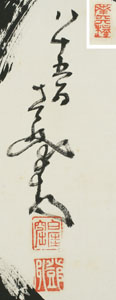zenga
月が鳴いたか, Ensô - “Is that the moon is calling?”Signed: 85 years old Nantembô Tôjû
Seals: Hakugaikutsu, Tôjû, Natembô (tp)
Technique: sumi on paper 33.4 x 34.6
Mounting: blue crushed paper and brown paper 112 x 37.4
Condition: good
月が鳴いたか part of the haiku 一声は 月が鳴いた かほととぎす
Hitokoe wa tsuki ga naita ka hototogisu.
A shriek -
is that the moon is calling?
A cuckoo.
Nantembô, Tôjû Zenchû, started painting when he was already more than 65 years old. Despite this relatively advanced age he was one of the most productive and important Zenga artists in the Meiji and Taishô era.
Keisuke (Nantembô) was born in the Shioda samurai family in Karatsu, Saga Prefecture in North-West Kyûshû. At the age of 7 he resolved to become a monk and at the age of 11 he began his training in the Yûkô-ji temple in Hirado where he received the name Nakahara Tôjû. Six years later he travelled to Kyôto to enter the Yamashiro Hachiman Daruma-dô and got trained at Empukuji temple. Most of his mature life he spent travelling and teaching. After meeting Yamaoka Tesshû (1836-1888) in 1885 they established a Zen training center at the Dorin-ji temple. Both men greatly influenced each other and Nantembô learned much of his style from Tesshû.
He became abbot of Zuigan-ji, Matsushima in 1891 and in 1902 abbot of Bairin-ji and Kaisei-ji. In 1908 Nantembô became 586th generation kanchô (Chief abbot) of the Myôshin-ji, but at the Kaisei-ji he spent the rest of his life.
In the West Nantembô is without any doubt the best-known 20th century Zen painter. He derived his name Nantembô from his bô (staff) cut from a 200-year-old Nanten tree. He used it to instruct his students and it illustrates his kôan: "If you speak, Nantembô; if you don't speak, Nantembô" (or, "To the enlightened it is a nanten staff, to the unenlightened it is (only) Nanten." Berry).
Reference:
Welch 1995
Seo p.17-34
Addiss p.186-203
Berry 2001 p. 176
Price: SOLD

